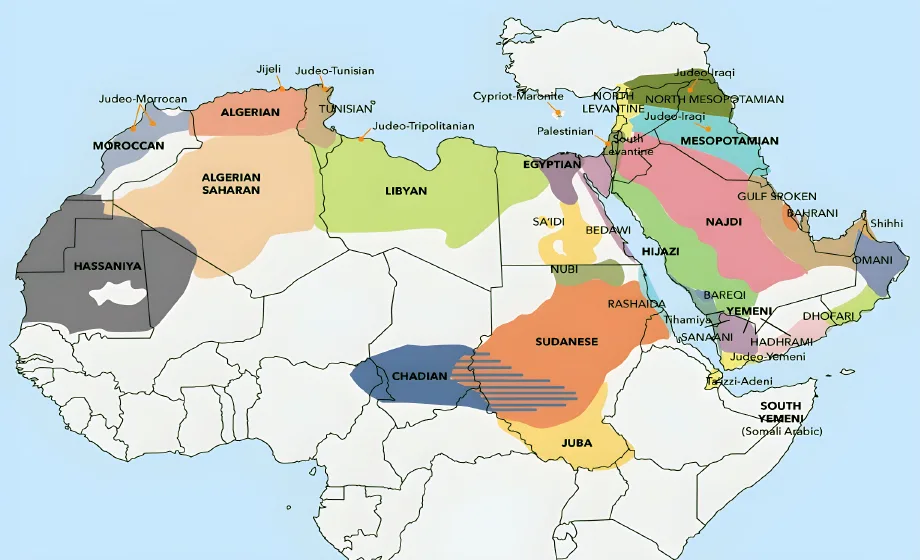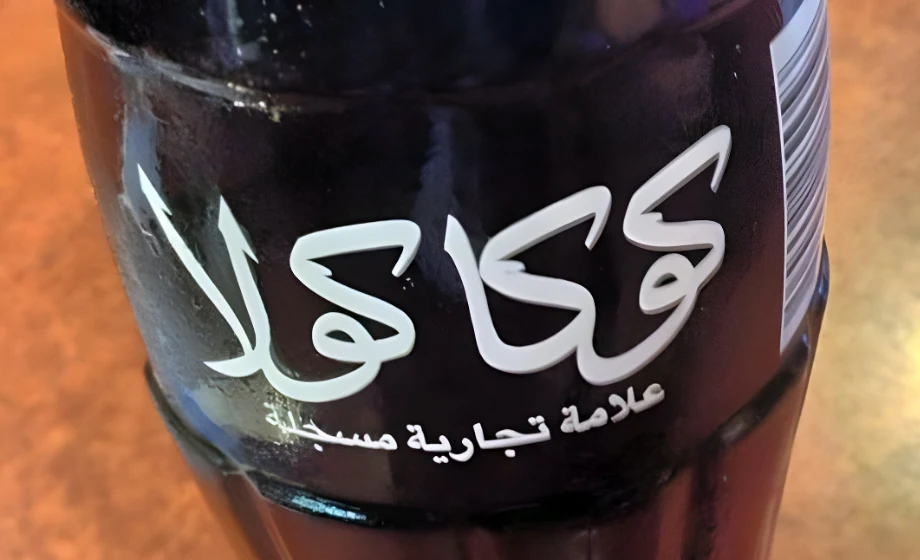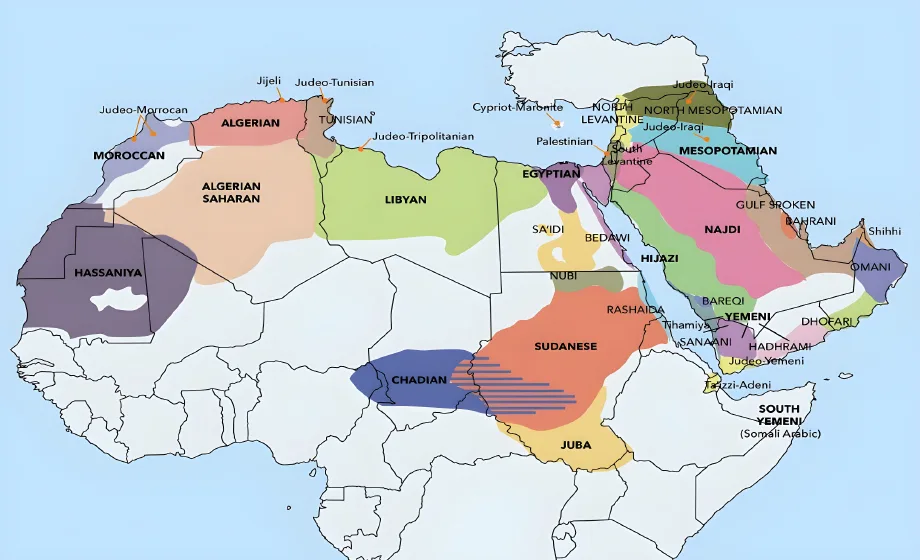This article is part of our crash course series on Arabic dialects.
Please also check out our in-depth guides on Moroccan, Egyptian, and Levantine Arabic dialects.
In this article, we give an overview of how Arabic dialects are different from Modern Standard Arabic, and how they differ from one another. If you’ve studied some MSA before and are thinking of learning a dialect, this article will give you a better idea of what to expect.
Looking for professional Arabic translation (Modern Standard or any dialect)? Head over to our quote page to get started.
Maybe you’ve studied Modern Standard Arabic (MSA) for a few years with the depressing knowledge that you’ll hardly understand a word of the local dialect when you land in the Arab world. But after those late nights with verb tables and flashcards, going back to square one with one of the dozen-plus Arabic dialects is the last thing on your mind.
Or perhaps you have some experience with one Arabic dialect, but now you’re off to a new country and hesitant to start all over. You’re wondering how much of your knowledge will transfer and how much is just baggage that will trip you up as you try to learn new words and pronunciation.
The numerous Arabic dialects and their interplay with the classical language are part of the richness and fascination of Arabic, but it is also one of the perpetual frustrations of students learning Arabic as a second language.
That’s why we’ve created this guide.
This guide is for readers who know some Arabic and need a crash course to get oriented in a new dialect fast.
The Key to Learning a New Arabic Dialect
How do you say “United Nations” in Egyptian, Iraqi, or Moroccan Arabic? It’s pretty much the same words in every dialect, as well as MSA: “al-umam al-muttahida”. But how do you say “I want to eat something now”? In this case there are as many ways to say it as there are dialects.
Egyptian: أنا عايز آكل حاجة دلوقتي (Ana ‘ayez aakol haga dilwa’ti)
Iraqi: أريد أكل شي هسة (Areed akol shi hissa)
Moroccan: بغيت ناكل شي حاجة دابا (bghiit nakul shi haja daba)
This is because it is precisely the words used most frequently in day-to-day life that change so dramatically from region to region. This dynamic is what makes it so frustrating to feel helpless in an airport or taxicab-type situation, even after several semesters or years studying fusha.
This also has hidden advantages: most Arabic students can “hack” the dialect learning process to 30 common words and structures in the local dialect. These 30 words are often the most basic and most used words in the language — words like “want,” “will” and “can” — but it is precisely these words that differ most between MSA and the dialects, as well as between the dialects themselves.
Every Arabic dialect has its own wealth of terms, expressions, proverbs, and slang that you need to master to sound like a native speaker. That’s not the goal here.
All the grammar and vocabulary you studied while learning MSA? You still get to use it as a base — you just need to switch out these 30 keywords to adapt MSA to the local dialect.
Now, are you going to be able to pass for an Egyptian, a Syrian, or a Moroccan with this approach? Probably not.
Does it enable you to take a taxi, order food, argue with a police officer, and have real conversations with locals? Definitely. (Arguing with a police officer is not recommended though)
We’ve created a separate guide for every major Arabic dialect that will give you these 30 keys words and some other basic foundations, but first, it’s useful to have a general overview of what features separate the colloquial Arabic dialects from MSA. There are a few general shifts that happen to nearly all dialects in one way or another, and that’s what the rest of this article will explain.
As part of that, we first have to address the elephant in the room: diglossia.
Understanding Diglossia and Arabic Dialects
What does diglossia really mean?
The term “diglossia” is thrown about a lot when discussing the relationship between Modern Standard Arabic and the various dialects. It perplexes beginning Arabic students with questions like “Should I learn MSA or a dialect?” and “If I learn a dialect, which dialect should I learn?“ and “If I learn MSA or a dialect, how hard is it to go from one to another?”
“Diglossia” gives the impression that Arabic is somehow split into two languages when in reality Arabic exists in a continuum. At the one extreme, there is the formal, classical language, with its complicated system of case endings (‘i’rab) and extensive vocabulary. Then at the other end, there is the colloquial language of uneducated speakers. But it is difficult to point to a certain variety of languages and say that it is “pure” MSA or “pure” dialect. Even in literary texts, you will find vocabulary and structures that evoke the author’s native dialect, while when discussing politics in the cafe, it is impossible not to resort to terminology originating in MSA.
But the language used in everyday life lies somewhere in between. Discussing politics in a cafe? Navigating bureaucratic procedures at a government office? In many contexts, the grammar and pronunciation will be based on the local dialect, while the vocabulary will draw heavily on MSA.
Therefore, if you’re a student of Arabic who has started with MSA, your goal should not be to start speaking 100% dialect right away but to gradually shift the balance to 90% MSA / 10% dialect, then 80% MSA / 20% dialect, and so on, until you start speaking like a local.
The first step is to realize what elements from MSA you can forget.
An Overview of the Differences between MSA and Arabic Dialects
Simplifications
The good news is that when going from MSA to a dialect, most of the changes you need to make involve dropping a lot of the rules and structures that make MSA so challenging in the first place.
Confused about trying to conjugate verbs for the dual form, and whether you need to say تفعلان or تفعلين in a given sentence? In the dialects, you don’t have to — you just use the plural.
Awkwardly writing اجتمعوا instead of اجتمعن when talking about الناشطات المصريات? No need to worry — in the dialects there is no feminine plural.
Not catching the internal vowel shift that distinguishes كُتِبَ from كَتَبَ? The dialects make it easier for you! They form the passive with more obvious constructions than the mabni lil-majhul.
Downright stumped about marfu’, mansub, majzum, majrur and all the little changes that happen to the end of verbs and nouns? The dialects put an end to that confusion and eliminate MSA’s case system.
All of these structures that gave you a headache when first learning Arabic are eliminated or converted to their simpler equivalent.
Pronunciation
Pronunciation is what really throws people for a loop when first learning an Arabic dialect. The ponderous, dignified sound of MSA splits off into a dozen different inflections. Some dialects may sound more staccato and jumpy, others more melodious and sing-songy. And some might even cease to sound like Arabic altogether!
You will have to attune your ear to the new dialect you’re learning — and over time, drag your tongue along for the ride to pronounce things correctly. But fortunately, there are a few common shifts in pronunciation shared across multiple dialects. If you internalize these changes, a whole range of Arabic colloquial speech will become intelligible for you.
The following are the most common pronunciation shifts shared across Arabic dialects:
Consonants
1 . Alef أ
Dialect pronunciation: In the middle of words, the hamza usually drops out and is replaced by a lengthened version of the vowel preceding it. So for example, رأس (ra’s) becomes راس (raas) and ذئب (dhi’b) becomes (deeb).
Examples:
MSA: ذئب (dhi’b) > deeb
MSA: زبائن > زباين zaba’in > zabayin
MSA: نائم > نايم (na’im > nayim)
2. Dhaal ذ
Dialect pronunciation: In some dialects, pronunciation alternates between English “z” and “d” depending on the word; in other dialects, shifts entirely to “d”
Examples:
MSA: أستاذ (ustadh) > Egyptian ustaz, Moroccan ustad
BUT
MSA: ذرّة (dhurra) > Egyptian durra, Moroccan dra
3. Thaa’ ث
Dialect pronunciation: In some dialects, pronunciation alternates between English “t” and “s” depending on the word; in other dialects, shifts entirely to “t”
Examples:
MSA مثلًا > Levantine masalan, Moroccan matalan
BUT
MSA ثلاثة (thalatha) > Levantine tlateh / Moroccan tlata
4. Jim ج
Dialect pronunciation: Purist MSA pronunciation of the letter is like the dg in “bridge.” In most dialects shifts to a sound like the “g” in regime. In the Egyptian dialect, it takes on the sound of g in “girl” (e.g. “camel” is gamal and not jamal)
5. Dad ض
Dialect pronunciation: In most dialects, the dad retains its MSA pronunciation. However, in the Iraqi dialects and several dialects of the Arabian peninsula, it takes on the same emphatic z sound of ظ.
6. Dhaa’ ظ
Dialect pronunciation: In Western dialects, tends to shift to ض sound in all words. In some Eastern dialects (Egyptian and Levantine), alternates between ض sound and emphatic z sound.
Examples:
MSA مظاهرة > Egyptian muzahera / Moroccan mudahera
BUT
MSA: عَظم (bone) > Egyptian ‘adm / Moroccan ‘adem
7. Qaf ق
Dialect pronunciation: Three possibilities: becomes replaced by hamza, shifts to “g” sound, or retains MSA pronunciation
Examples:
MSA قلتُ (I said)
Egyptian: ‘ult
Levantine: ‘ilit
Iraqi: gilit
Moroccan: gult/qult
Vowels
The dialects also undergo a number of changes in the internal vowels of words (especially short vowels, such as fatha, damma, and kasra). Getting these vowels right is not as essential to understanding or being understood, but they often define the particular “music” of each dialect.
Examples include:
- Loss of diphthongs (such as the shift of aw to o and ay to e). For example, MSA bayt becomes a pure vowel bet and mawt (موت) shifts to mot.
- Internal vowel shifts (i.e. in Levantine dialects damma frequently shifts to kasra). For example, the past tense of قال is not qultu but rather ‘ilit.
- Suppression of short vowels and merger to schwa sound (characteristic of Western dialects such as Moroccan).
- Taltalah: shift of fatha to kasra in certain high frequency contexts.
- Anta / anti (you) > inta / inti
- Al- of definite article > il-
- Subject prefix of present tense verbs: taktib (you write) > tiktib; yaftah (he opens) > yiftah
Grammar
Verb Morphology
The main tendency of verbs in Arabic dialects compared to MSA is to eliminate or reduce features that depend on internal short vowels for the meaning. This is seen in two prominent phenomena.
The first is the disappearance of the al-mabni lil-majhul construction (which involves the replacement of an initial fatha by damma: kataba “he wrote” vs. kutiba “it was written”). The dialects prefer to express the passive voice by adapting one of the ten forms of the verb, such as Form V or Form VII. For example, اتمسك (itmasak) in Egyptian Arabic vs. انمسك (inmasak) in Levantine Arabic, both meaning “to be caught.”
The other result of the dialects’ de-emphasizing of short vowels is the avoidance of certain verbal forms out of the ten form system that exists in MSA. Most notably form IV (أفعل), which is usually replaced by a form II verb. For example, in Egyptian Arabic, the MSA verb أرى (to show) becomes a form II verb ورّى.
Another simplification in the verb system of dialects is the treatment of “doubled” or “geminate” verbs. In MSA, doubled verbs such as مرّ, ردّ, حسّ, and شمّ reduplicate the second root consonant in certain persons of the past tense, e.g. مررتُ (I passed), شممتَ (you smelled), حسسنا (we felt), رددتم (you pl. responded). In contrast, most dialects replace this type of reduplication with a long “ay” sound. Or to put it another way, they treat these verbs as if they were defective verbs (أفعال ناقصة) in these past tense forms.
| 1 sing. | رديت (raddayt) | 1 pl. | ردينا (raddayna) |
| 2 sing. (masc.) | رديت (raddayt) | 2 pl. | رديتو (raddaytu) |
| 2 sing. (fem.) | رديتي (raddayti) | ||
| 3 sing. (masc.) | رد | 3 pl. | ردوا |
| 3 sing. (fem.) | ردّت |
Verb Tenses and Moods
In most dialects, the present tense involves adding a letter to the beginning of what would be the MSA present tense. For example, in Levantine and Egyptian Arabic, this letter is “b,” while in Moroccan Arabic, it’s “k.”
So MSA أستخدم (I use) becomes باستخدم (bastakhdim) in Egyptian Arabic
Likewise, تدرس (you study) becomes بتدرس (btidris) in Levantine Arabic
In Moroccan, verbs are preceded by a ك, such as كتقرى (katqraa, you study)
By contrast, the form of the verb without this present tense marker (and thus a form that resembles the normal present tense verb in MSA) is used as the subjunctive form of the verb — that is, the verb that follows expressions of wanting, wishing, ability and necessity.
Frequently, this means you will see a sequence of two verbs, with the first one in the present tense and the second verb in the subjunctive. Note that in this case, there is no need to insert أن between the two verbs, as is in the case of MSA.
| Dialect Version | MSA | Translation |
|---|---|---|
| أنا عايز أدرس عربي (ana ‘ayez adrus ‘arabi) | أنا أريد أن أدرس العربية | I want to study Arabic |
| بدي أنزل هون (biddi anzil hun) | أريد أن أنزل هنا | I want to get out here (said in a taxi, for example) |
| بغيت نمشي للقهوة (bghiit nmashii lil-qahwa) | اريد أن أذهب الى المقهى | I want to go to the cafe. |
Other types of words can trigger the use of the subjunctive besides verbs. In several dialects, for example, the words “have to” and “may / be able to” are adjectives used by themselves and followed by a verb in the subjunctive.
| Dialect Version | MSA | Translation |
|---|---|---|
| لازم تدفع الحساب (laazim tidfa’ il-hisab) | من اللازم أن تدفع الحساب | You have to pay the bill |
| ممكن أقعد هنا؟ (mumkin ‘a3ud hina) | هل يمكنني أن أجلس هنا؟ | Can I sit here? |
| خصني نخرج دابا | من اللازم أن أخرج الآن | I need to leave now |
Negation
MSA has a complicated system for negating verbs, where the negating participle differs according to the tense of the verb (i.e.لا for the present, لن for the future, and لم or ما for the past tense). In the dialects, this is greatly simplified, with ما being used as the main negating participle for both the present and past tense.
One complication introduced in a number of dialects is adding a ش to the end of the verb being negated, creating a sort of negation “sandwich,” with the verb being placed between ما and ش. This structure is found in both the past and present tense in the dialect where it’s used. For example ماقلتش (ma ‘ultish) “I didn’t say,” ما بقولش (ma ba’ulsh) “I’m not saying.”
For the future, most dialects replace the س / سوف that is the future tense marker in MSA with a different letter or word, and the verb is otherwise unchanged. In Levantine Arabic, this word is رح (rah), in Moroccan Arabic it’s غادي and in Egyptian Arabic it’s just a حـ (ha) added to the beginning of the verb.
Possessive Markers
The possessive suffixes remain identifiably the same in the dialects compared to MSA, with just a few simplifications and changes in pronunciation.
The main simplification is that the dual and feminine plural forms used in MSA are dropped, with the masculine plural forms being used instead.
In terms of pronunciation, the main change is that nouns in the dialects don’t take i’rab case endings, and so the possessive suffix is affixed directly to the noun with no vowel in between. For example, bayt-u-na > bet-na
For the singular “you” forms (-ka and -ki) and the masculine singular form (-hu), the final vowel is placed back before the consonant and the word as a whole ends with a sukun.
Examples: bayt-u-ka > bet-ak, bayt-u-ki > bet-ik, bayt-u-hu > bet-uh
The 1st person singular and plural forms, and the 3rd person singular feminine form are the forms that are the most unchanged from MSA and across the dialects.
Meanwhile, the forms that tend to vary the most across the dialects are the second and third person plural forms (كم- and هم- in MSA). For more detail on this, see our individual dialect articles.
Another possessive structure that is very common in Arabic dialects is the use of a separate word (rather than a suffix) to express possession. With this structure, the possessive suffixes are not added directly to the noun itself, but rather to this possessive marker. For example, this possessive word in Egyptian Arabic is bita’ (بتاع), while in Levantine Arabic it’s taba’ (تبع) and in Moroccan Arabic it’s diyal (ديال). So, for example, to say “my house” in Egyptian Arabic, you would add the possessive suffix for “my” to the end of this word, giving you البيت بتاعي.
Note that this structure can also be used to replace idafa in expressing the relationship between two nouns, e.g. البيت بتاع الطلاب (the students’ house).
Demonstrative Adjectives
The demonstrative adjectives (this, that) tend to be derived from هذا \ هذه in most dialects, sometimes with the shift of ذ to د mentioned above. For example, in Lebanese Arabic “this” is هيدا and in Moroccan Arabic, it’s هادا.
One peculiar feature in Egyptian Arabic is that the demonstrative adjectives are placed after the noun rather than before it, e.g. البنت دي “this girl”
Vocabulary
When it comes to vocabulary, there’s good news and bad news.
The good news is that a lot of the vocabulary you learned when studying MSA is the same, or at least understood, in colloquial contexts.
The bad news is that the vocabulary that is most different from MSA tends to be the highest frequency words and the words most necessary for navigating daily life.
As a case in point, the main categories of vocabulary that distinguish the dialects from MSA and the dialects from one another are the following:
- Basic function words such as words marking the present or future tense
- Interrogatives (who, what, where…)
- Temporal adverbs (now, early, late, soon, today, tomorrow, yesterday…)
- Commonly occurring verbs such as want, go, become, do, work
- Food, clothing, and other household items
By contrast, the political, intellectual, and religious vocabulary of the dialects is almost entirely derived from MSA.
Finally, there are two verbs that are not found in MSA, but which are almost universally used across the dialects: jab and shaf (“to bring” and “to see,” respectively).
In MSA, the concept “to bring,” is expressed by the idioms أتى بـ and جاء بـ (literally “to come with something”). In the dialect form jab (yijeeb in the present tense), the preposition بـ has become fused with the verb جاء to form a single verb جاب, which is conjugated like a hollow verb (الفعل الأجوف).
Then the verb شاف (in the present tense, يشوف) replaces MSA رأى as the primary verb meaning “to see.”
With these two verbs, you’re well on your way to converting the MSA you know to the dialect of your choice.
Resources & Next Steps
For articles about individual dialects, each of which includes a list of the top 30 most essential phrases in the dialect, go to the links below:
Our goal is to cover all the dialects of the Arab world, so if you don’t see the dialect you’re looking for on the list, you can rest assured that it’s in the pipeline! Or drop us a line through our Contact page to let us know which dialects you think we should prioritize.



